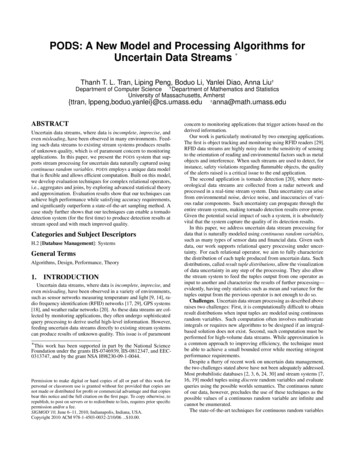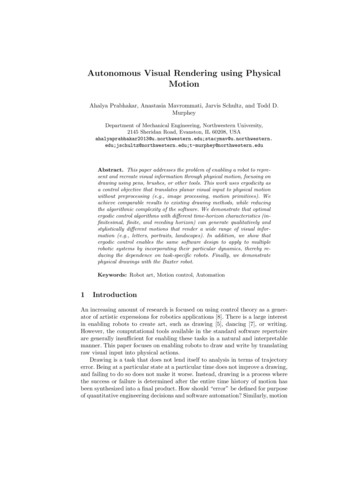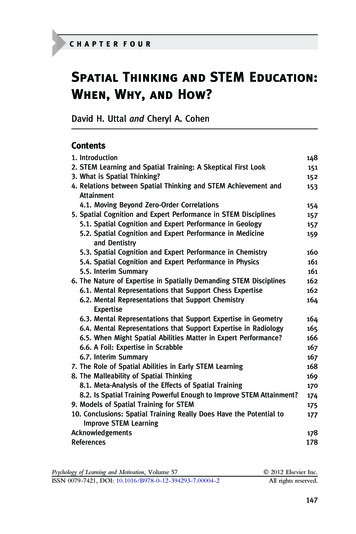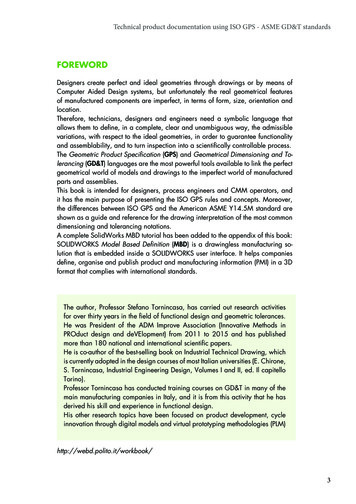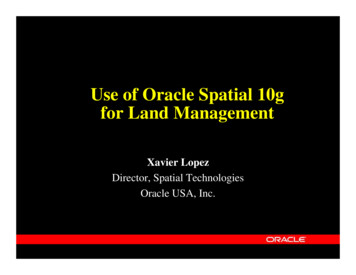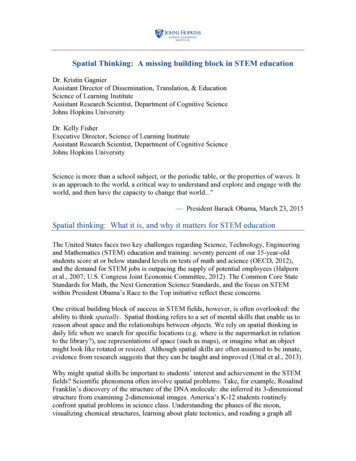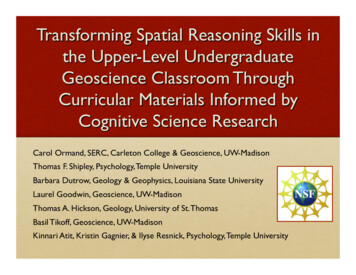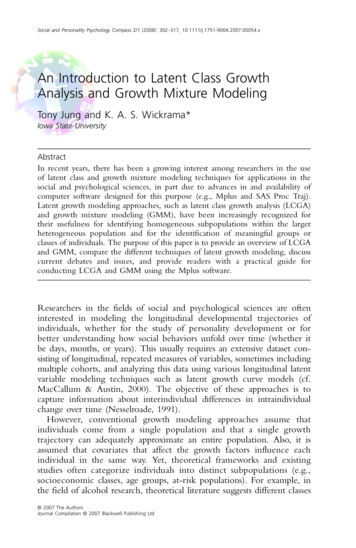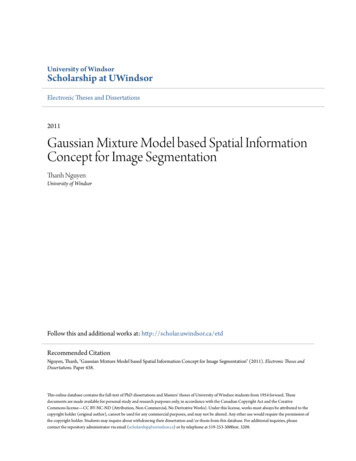
Transcription
University of WindsorScholarship at UWindsorElectronic Theses and Dissertations2011Gaussian Mixture Model based Spatial InformationConcept for Image SegmentationThanh NguyenUniversity of WindsorFollow this and additional works at: http://scholar.uwindsor.ca/etdRecommended CitationNguyen, Thanh, "Gaussian Mixture Model based Spatial Information Concept for Image Segmentation" (2011). Electronic Theses andDissertations. Paper 438.This online database contains the full-text of PhD dissertations and Masters’ theses of University of Windsor students from 1954 forward. Thesedocuments are made available for personal study and research purposes only, in accordance with the Canadian Copyright Act and the CreativeCommons license—CC BY-NC-ND (Attribution, Non-Commercial, No Derivative Works). Under this license, works must always be attributed to thecopyright holder (original author), cannot be used for any commercial purposes, and may not be altered. Any other use would require the permission ofthe copyright holder. Students may inquire about withdrawing their dissertation and/or thesis from this database. For additional inquiries, pleasecontact the repository administrator via email (scholarship@uwindsor.ca) or by telephone at 519-253-3000ext. 3208.
Gaussian Mixture Model based SpatialInformation Concept for Image SegmentationbyThanh Minh NguyenA DissertationSubmitted to the Faculty of Graduate Studiesthrough Electrical and Computer Engineeringin Partial Fulfillment of the Requirements forthe Degree of Doctor of Philosophy at theUniversity of WindsorWindsor, Ontario, Canada2011c 2011 Thanh Minh Nguyen
Author’s Declaration ofOriginalityI hereby declare that I am the sole author of this thesis. I certify that, to thebest of my knowledge, my thesis does not infringe upon anyone’s copyright norviolate any proprietary rights and that any ideas, techniques, quotations, orany other material from the work of other people included in my thesis, published or otherwise, are fully acknowledged in accordance with the standardreferencing practices. Furthermore, to the extent that I have included copyrighted material that surpasses the bounds of fair dealing within the meaningof the Canada Copyright Act, I certify that I have obtained a written permission from the copyright owner(s) to include such material(s) in my thesis andhave included copies of such copyright clearances to my appendix.I declare that this is a true copy of my thesis, including any final revisions, as approved by my thesis committee and the Graduate Studies office,and that this thesis has not been submitted for a higher degree to any otherUniversity or Institution.iii
AbstractSegmentation of images has found widespread applications in image recognition systems. Over the last two decades, there has been a growing research interest in model-based technique. In this technique, standard Gaussian mixturemodel (GMM) is a well-known method for image segmentation. The modelassumes a common prior distribution, which independently generates the pixellabels. In addition, the spatial relationship between neighboring pixels is nottaken into account of the standard GMM. For this reason, its segmentationresult is sensitive to noise. To reduce the sensitivity of the segmented resultwith respect to noise, Markov Random Field (MRF) models provide a powerful way to account for spatial dependencies between image pixels. However,their main drawback is that they are computationally expensive to implement.Based on these considerations, in the first part of this thesis (Chapter4), we propose an extension of the standard GMM for image segmentation,which utilizes a novel approach to incorporate the spatial relationships between neighboring pixels into the standard GMM. The proposed model is easyto implement and compared with the existing MRF models, requires lessernumber of parameters. We also propose a new method to estimate the modeliv
parameters in order to minimize the higher bound on the data negative loglikelihood, based on the gradient method. Experimental results obtained onnoisy synthetic and real world grayscale images demonstrate the robustness,accuracy and effectiveness of the proposed model in image segmentation.In the final part of this thesis (Chapter 5), another way to incorporatespatial information between the neighboring pixels into the GMM based onMRF is proposed. In comparison to other mixture models that are complexand computationally expensive, the proposed method is robust and fast toimplement. In mixture models based on MRF, the M-step of the EM algorithmcannot be directly applied to the prior distribution for maximization of the loglikelihood with respect to the corresponding parameters. Compared with thesemodels, our proposed method directly applies the EM algorithm to optimizethe parameters, which makes it much simpler. Finally, our approach is usedto segment many images with excellent results.v
To my beloved Dad and Mom&My beloved wife, Dang Nguyen Thanh Yenvi
AcknowledgementsI am deeply indebted to my thesis advisor, Prof. Jonathan Wu, for his informedguidance, understanding, support and encouragement through the years. Hisdepth and vision in this area are truly admirable, and he has been an inspiration to me in many ways.I am grateful to my committee members Prof. Narayan Kar, Prof.Huapeng Wu, Prof. Dan Wu, and Prof. Peter X. Liu for reviewing my thesisand making many excellent suggestions to improve its substance and presentation. Their openness, encouragement and interest in my research were veryimportant to me.Thanks also go to Andria Ballo and Shelby Marchand from Departmentof Electrical and Computer Engineering for their reminders and assistance invarious administrative tasks.I am grateful that during the past four years, I get to know manyother talented graduate students: Siddhant Ahuja, Mohammed Golam Sarwer, Baradarani Aryaz, Rashid Minhas, AbdulAdeel Mohammed, DibyenduMukherjeey, and Ashirbani Saha. I want to thank them for their help, support, interest, and valuable hints. I would also like to thank other membersvii
in our lab for encouragements and the joys and tears that we shared.I thank my parents who always stand beside me. I could not completethis long journey without their never-ending love, support and prayer. I cannotfind any word to express my deep appreciation to them. I just want to tellthem how much I love them. I love you, Dad and Mom, and thanks for alwaysbeing there for me.Finally, I thank my best friend and beloved wife Dang Nguyen ThanhYen, who always takes care of many things around me since I came here sothat I could concentrate on this thesis. Her love has been a strong energy formy entire study.This research has been supported in part by the Canada Research ChairProgram, AUTO21 NCE, the NSERC Discovery grant, and OGS.Thanh Minh NguyenThe University of WindsorAugust 2011viii
Table of ContentsAuthor’s Declaration of tsviiList of FiguresxiiiList of TablesxxSymbols and Abbreviationsxxi1 Introduction11.1General Introduction . . . . . . . . . . . . . . . . . . . . . . .11.2Thesis Overview . . . . . . . . . . . . . . . . . . . . . . . . . .72 Standard Finite Mixture Model for Image Segmentation2.1Probability Distributions . . . . . . . . . . . . . . . . . . . . .ix1010
2.1.1The Gaussian Distribution . . . . . . . . . . . . . . . .102.1.2The Student’s-t distribution . . . . . . . . . . . . . . .122.2Maximum likelihood for the Gaussian . . . . . . . . . . . . . .142.3Standard Finite Mixture Model . . . . . . . . . . . . . . . . .162.3.1Gaussian Mixture Model . . . . . . . . . . . . . . . . .162.3.2Student’s-t Mixture Model . . . . . . . . . . . . . . . .19The Expectation Maximization (EM) Algorithm . . . . . . . .222.4.1EM Algorithm for the Gaussian Mixture Model . . . .222.4.2Relation between EM and K-means . . . . . . . . . . .252.5Gradient-Based Optimization Techniques . . . . . . . . . . . .272.6Image Segmentation Evaluation . . . . . . . . . . . . . . . . .302.7Conclusions . . . . . . . . . . . . . . . . . . . . . . . . . . . .312.43 Gaussian Mixture Model based Markov Random Field333.1Introduction . . . . . . . . . . . . . . . . . . . . . . . . . . . .333.2Gaussian Mixture Model based MRF for the Pixel Labels . . .343.2.1Markov Random Field Theory . . . . . . . . . . . . . .343.2.2Hidden Markov models . . . . . . . . . . . . . . . . . .363.33.4Gaussian Mixture Model based MRF for the Priors of the PixelLabels . . . . . . . . . . . . . . . . . . . . . . . . . . . . . . .39Conclusions . . . . . . . . . . . . . . . . . . . . . . . . . . . .444 An Extension of the Standard Mixture Model for Image Segmentation454.145Introduction . . . . . . . . . . . . . . . . . . . . . . . . . . . .x
4.2Proposed Method . . . . . . . . . . . . . . . . . . . . . . . . .464.3Parameter Learning . . . . . . . . . . . . . . . . . . . . . . . .504.4Experiments . . . . . . . . . . . . . . . . . . . . . . . . . . . .524.4.1Synthetic Images . . . . . . . . . . . . . . . . . . . . .544.4.2Natural Images . . . . . . . . . . . . . . . . . . . . . .58Conclusions . . . . . . . . . . . . . . . . . . . . . . . . . . . .654.55 Fast and Robust Spatially Constrained Gaussian MixtureModel for Image Segmentation665.1Introduction . . . . . . . . . . . . . . . . . . . . . . . . . . . .665.2Proposed Method . . . . . . . . . . . . . . . . . . . . . . . . .705.3Experiments . . . . . . . . . . . . . . . . . . . . . . . . . . . .745.3.1Segmentation of Synthetic Images . . . . . . . . . . . .755.3.2Segmentation of Grayscale Natural Images . . . . . . .815.3.3Segmentation of Colored Images . . . . . . . . . . . . .83Conclusions . . . . . . . . . . . . . . . . . . . . . . . . . . . .875.46 Conclusions896.1Summary of Main Contributions . . . . . . . . . . . . . . . . .896.2Future Directions . . . . . . . . . . . . . . . . . . . . . . . . .91References94Appendix A110Publications112xi
Vita Auctoris115xii
List of Figures2.1Plot of the Gaussian distribution showing the mean µ and standard deviation σ. . . . . . . . . . . . . . . . . . . . . . . . . .2.211Plot of Student’s-t distribution for µ 0 and Λ 1 for various values of v. The limit v corresponds to a Gaussiandistribution with mean µ and precision Λ. . . . . . . . . . . .2.3The graphical representation of a Gaussian mixture model fora set of N pixel xi . . . . . . . . . . . . . . . . . . . . . . . . .2.41317Synthetic image, (a): original image, (128x128 image) (b): Corrupted original image with Gaussian noise (0 mean, 0.02 variance), (c): standard GMM. . . . . . . . . . . . . . . . . . . . .2.518Real world image (321x481 image resolution), (a): original image, (b): Corrupted original image with Gaussian noise (0 mean,0.02 variance), (c): standard GMM . . . . . . . . . . . . . . .2.618Synthetic image, (a): original image, (128x128 image) (b): Corrupted original image with Gaussian noise (0 mean, 0. 005 variance), (c): standard GMM, (c): standard SMM. . . . . . . . .xiii21
2.7EM algorithm for the mixture of gaussians, (a): The original2D point set with the initial condition, (b): Result of GMMwith this initial condition. . . . . . . . . . . . . . . . . . . . .3.124Synthetic image, (a): original image, (b): Corrupted originalimage with Gaussian noise (0 mean, 0.05 variance), (c): standard GMM, (d): SIMF [63]. . . . . . . . . . . . . . . . . . . .3.238Synthetic image, (a): original image, (b): Corrupted originalimage with Gaussian noise (0 mean, 0.01 variance), (c): standard GMM (time 5.5s), (d): SVFMM [72] (time 246.1s). .4.143The first experiment (128x128 image resolution), (a): originalimage, (b): Corrupted original image with Gaussian noise (0mean, 0.05 variance), (c): K-means (MCR 17.315%), (d):standard GMM (MCR 33.982%), (e): SVFMM (MCR 13.671%), (f): NEM (MCR 17.034%), (g) ICM (MCR 9.605%), (h): MODEF (MCR 7.781%), (i): SIMF (MCR 7.725%), (k): MEANF (MCR 7.721%), (l) HMRF-FCM(MCR 0.823%), (m): The proposed method (MCR 0.653%). 54xiv
4.2The second experiment (128x128 image resolution), (a): original image, (b): Corrupted original image with mixed noise (salt and pepper noise (0.03%) Gaussian noise (0 mean, 0.01variance)), (c): K-means (MCR 24.609%), (d): standardGMM (MCR 40.209%), (e): SVFMM (MCR 22.338%), (f):ICM (MCR 22.001%), (g): MODEF (MCR 12.744%), (h):SIMF (MCR 13.307%), (i): MEANF (MCR 12.200%), (k)FGFCM (MCR 5.562%), (l) HMRF-FCM (MCR 3.692%),(m): The proposed method (MCR 2.789%). . . . . . . . . .4.356Affect of the simple competitive selection, (a): original image,(b): Corrupted original image with Gaussian noise (0 mean,0.03 variance), (c): MODEF (MCR 3.512%), (d): MODEFwith the simple competitive selection (MCR 3.117%), (e):proposed method without the simple competitive selection (MCR 0.199%), (f): proposed method with the simple competitiveselection (MCR 0.197%). . . . . . . . . . . . . . . . . . . .4.458Images from the Berkeleys grayscale image segmentation dataset,(a): 135069, (b): 124084, (c): 58060, (d): 353013 with Gaussian noise (0 mean, 0.001 variance), (e): 239007, (f): 46076,(g): 15088 with Gaussian noise (0 mean, 0.005 variance), (h):374067 with Gaussian noise (0 mean, 0.01 variance), (i): 302003with Gaussian noise (0 mean, 0.01 variance). . . . . . . . . . .xv59
4.5Image segmentation results obtained by employing the proposedmethod, (a): 135069, (b): 124084, (c): 58060, (d): 353013with Gaussian noise (0 mean, 0.001 variance), (e): 239007, (f):46076, (g): 15088 with Gaussian noise (0 mean, 0.005 variance),(h): 374067 with Gaussian noise (0 mean, 0.01 variance), (i):302003 with Gaussian noise (0 mean, 0.01 variance). . . . . . .4.660Grayscale image segmentation (55067), (a): original image, (b):K-means (PR 0.879), (c): standard GMM (PR 0.843), (d):SVFMM (PR 0.882), (e): ICM (PR 0.880), (f): MODEF(PR 0.882), (g): MEANF (PR 0.881), (h): FGFCM (PR 0.879), (i): HMRF-FCM (PR 0.887), (k): The proposedmethod (PR 0.891). . . . . . . . . . . . . . . . . . . . . . .4.762Noisy grayscale image segmentation (24063), (a): original image, (b): corrupted original image with Gaussian noise (0 mean,0.005 variance), (c): K-means (PR 0.778), (d): standardGMM (PR 0.765), (e): SVFMM (PR 0.787), (f): MODEF(PR 0.814), (g): MEANF (PR 0.818), (h): FGFCM (PR 0.796), (i): HMRF-FCM (PR 0.815), (k): The proposedmethod (PR 0.826). . . . . . . . . . . . . . . . . . . . . . .4.863Computational cost (in seconds) comparison, (a): original image, (b): K-means (0.7 sec), (c): standard GMM (36 sec), (d):ICM (169 sec), (e): MODEF (390 sec), (f): SIMF (432 sec),(g): MEANF (445 sec), (h): The proposed method (61 sec). .xvi64
4.9Minimization Progress of the negative log-likelihood function ofthe proposed algorithm, for the final experiment. . . . . . . . .5.164The first experiment (128x128 image resolution), (a): original image, (b): Corrupted original image with Gaussian noise(0 mean, 0.03 variance), (c): K-means, (d): Standard GMM(MCR 41.67%), (e): SVFMM (MCR 23.28%), (f): CA–SVFMM (MCR 20.29%), (g): ICM (MCR 20.23%), (h):SIMF (MCR 3.83%), (i) MEANF (MCR 3.55%), (j): Proposed method (MCR 1.13%). . . . . . . . . . . . . . . . . .5.2Maximization progress of the log-likelihood of the proposedmethod of the first experiment. . . . . . . . . . . . . . . . . .5.37677The second experiment (128x128 image resolution), (a): originalimage, (b): Corrupted original image with Gaussian noise (0mean, 0.05 variance), (c): K-means, (d): Standard GMM (MCR 35.02%), (e): SVFMM (MCR 12.01%), (f): CA–SVFMM(MCR 11.16%), (g): ICM (MCR 7.65%), (h): SIMF (MCR 5.65%), (i) MEANF (MCR 5.94%), (j): Proposed method(MCR 1.05%). . . . . . . . . . . . . . . . . . . . . . . . . .xvii78
5.4The third experiment (128x128 image resolution), (a): originalimage, (b): Corrupted original image with Gaussian noise (0mean, 0.03 variance), (c): K-means, (d): Standard GMM (MCR 30.31%), (e): SVFMM (MCR 18.11%), (f): CA-SVFMM(MCR 17.73%), (g): ICM (MCR 5.90%), (h): SIMF (MCR 2.86%), (i) MEANF (MCR 2.70%), (j): Proposed method(MCR 0.21%). . . . . . . . . . . . . . . . . . . . . . . . . .5.580The fourth experiment (256x256 image resolution), (a): originalimage, (b): Corrupted original image with Gaussian noise (0mean, 0.1 variance), (c): Proposed method in Chapter 4 (MCR 0.10%, time 8.9s), (j): Proposed method in Chapter 4(MCR 0.22%, time 3.7s). . . . . . . . . . . . . . . . . . .5.681Grayscale natural image segmentation (80099), (a): original image, (b): Standard GMM, (c): SVFMM, (d): CA–SVFMM, (e):SIMF, (f) MEANF, (g): Proposed method, (h): Maximizationprogress of the log-likelihood of the proposed method of thisexperiment. . . . . . . . . . . . . . . . . . . . . . . . . . . . .5.782Grayscale natural image segmentation (86016), (a): original image, (b): Standard GMM, (c): SVFMM, (d): CA–SVFMM, (e):SIMF, (f) MEANF, (g): Proposed method, (h): Maximizationprogress of the log-likelihood of the proposed method. . . . . .xviii83
5.8Grayscale natural image segmentation (374067), (a): originalimage, (b): Standard GMM, (c): SVFMM, (d): SIMF, (e):Proposed method. . . . . . . . . . . . . . . . . . . . . . . . . .5.984Color image segmentation (310007), (a): original image, (b):Standard GMM, (c): SVFMM, (d): CA–SVFMM, (e): SIMF,(f) MEANF, (g): Proposed method, (h): Maximization progressof the log-likelihood of the proposed method. . . . . . . . . . .855.10 Color image segmentation (388016), (a): original image, (b):Corrupted original image with Gaussian noise (0 mean, 0.0015variance), (c): Standard GMM, (d): SVFMM, (e): CA–SVFMM,(f): ICM, (g) MEANF, (h): Proposed method. . . . . . . . . .865.11 (first row): original image, (second row): SVFMM, (third row):MEANF, (last row): Proposed method. . . . . . . . . . . . . .xix88
List of Tables4.1Comparison of the proposed method with other methods in termof MCR (%), for the first experiment. . . . . . . . . . . . . . .4.2Comparison of the proposed method with other methods in termof MCR (%), for the second experiment. . . . . . . . . . . . .4.376Computational cost (in seconds) comparison for the syntheticimage in the second experiment. . . . . . . . . . . . . . . . . .5.361Computational cost (in seconds) comparison for the syntheticimage in the first experiment. . . . . . . . . . . . . . . . . . .5.257Comparison of image segmentation results on Berkeley’s grayscaleimage segmentation dataset: Probabilistic Rand (PR) Index. .5.15579Comparison of the proposed method with other methods in termof MCR (%), for the third experiment, in the presence of varyinglevels of noise. . . . . . . . . . . . . . . . . . . . . . . . . . . .5.479Comparison of image segmentation results on Berkeley’s colorimage segmentation dataset: Probabilistic Rand (PR) Index. .xx87
Symbols and Abbreviationsxi:The i-th pixel of an imageN:The number of pixels in an imageΩj:The j-th label in an imageK:The number of labels in an imageNi:The neighborhood pixels of the i-th pixelΦ(xi Θj ):The Gaussian functionµj:The mean of the Gaussian function Φ(xi Θj )σj:The standard deviation of the Gaussian function:Φ(xi Θj ), for the case of a single real-valued variable xi:The covariance of the Gaussian function Φ(xi Θj ),:for the case of a D-dimensional vector xiπj:The prior probability of all pixel belonging to the label Ωjπij:The prior probability of the pixel xi belonging:to the label Ωj:The posterior probability of the pixel xi belonging:to the label ΩjΣjzijxxi
f (xi Π, Θ):The density function at an observation xip(X Π, Θ):The joint conditional densityL(Θ, Π X):The log-likelihood functionJ(Θ, Π X):The negative log-likelihood functionH(Π, Θ X):The objective functionE(Θ, Π):The error functionGMM:Gaussian mixture modelSMM:Student’s-t mixture modelMRF:Markov random fieldEM:Expectation maximizationSVFMM:Spatially variant finite mixture modelCA-SVFMM :Class adaptive spatially variant finite mixture modelNEM:Neighborhood expectation maximizationICM:Iterated conditional modelMODEF:Mode field algorithmSIMF:Simulated field algorithmMEANF:Mean field algorithmFGFCM:Fast generalized fuzzy c-meansHMRF-FCM :Hidden Markov random field based fuzzy c-meansMCR:The misclassification ratioPR:The probabilistic rand indexDicej:Dice similarity coefficient for the label Ωjxxii
Chapter 1Introduction1.1General IntroductionIn order to analyse the content of an image, it is often useful to construct asimpler representation of multiple segments. And the process to partition animage into non-overlapping regions that humans can easily separate is calledimage segmentation. In an image, various features can be used for segmentation process. These might be colour information that is used to create histograms, or information about the pixels that indicate boundaries or textureinformation.Segmentation is an important step of low level vision. An accuratelysegmented image provides detailed information about the objects present inan image and their respective boundaries. There are many applications of segmentation. For example, in a vision guided tool tracker system [1], [2], [3], therobot needs to track the appropriate components in automotive manufacturing1
environments, thereby increasing the productivity and profitability of automotive manufacturing enterprises and the global competitiveness. In the field ofmedical imaging [4], [5], [6], [7], segmentation plays an important role. Accurate medical image segmentation provides additional information that helps toprepare treatment scheme and to evaluate therapeutic effect. The applicationsof segmentation vary from the detection of synthetic aperture radar images [8],[9], video analysis [10], to magnetic resonance imaging (MRI) [11], and objectdetection [12], [13], [14] etc. In all these areas, the quality of the segmentedoutput affects on the quality of the final output largely. However, automatedsegmentation [15] is still a very challenging research topic, due to overlappingintensities and low contrast in images, as well as noise perturbation.Many previous works have been proposed for image segmentation, inparticular by the method of threshold [16], [17], [18]. However, thresholdingis significantly susceptible to low resolution, low contrast and signal to noiseratio. As for some part of the image, high intensity variation may correspondto edges of interest, while the other part may require high low variation. Theselection of the threshold is very crucial. A bad choice of threshold [19] leadsto a poor quality of the segmentation. Adaptive thresholding [20], [21], [22]often is taken as a solution to this. However, it cannot eliminate the problemof threshold selection [23].In order to avoid the above-mentioned disadvantages, an artificial neuralnetwork [24], [25], [26] is applied for image segmentation. In [27], the authorsclustered feature vectors extracted from an image using a neural network which2
minimized the distance between the feature vectors. Although this approachworked well in the examples shown, it led to sub-optimal image segmentation.This is because the pixels in general are spatially correlated and the approachpresented in this method did not incorporate any spatial information.Many algorithms have been developed for image segmentation includinggraph-based methods [28], [29], mean shift based methods [30], [31], histogrambased methods [32], multi-scale segmentation [33], and clustering methods [34],[35], [36]. In clustering methods, K-means [37], [86] and fuzzy c-means [38] aretwo well-known methods that have been widely used for segmenting an imagedue to their simplicity and ease of implementation. However, one of their maindrawbacks [39]–[42] is that these two methods ignore the spatial constraintsin an image.During the last decades, much attention has been given to model-basedtechniques [43], [44], [45], [100]–[105] to model the uncertainty in a probabilistic manner. In model-based techniques, standard Gaussian mixture model(GMM) [46]–[49] is a well-known method. It is a flexible and powerful statistical modeling tool for multivariate data. Many researchers have used it tostudy a number of key problems in the area of image segmentation [50], [51].In standard GMM, each pixel xi is considered to be a random variable whosepossibility density function Φ(xi Θj ) is a Gaussian function. The model assumes a common prior distribution πj , which independently generates the pixellabels. In order to estimate the model parameters, expectation maximization(EM) algorithm [52]–[57] is employed to maximize the log-likelihood of the3
given data set. The main advantage of the standard GMM is that it is easyto implement and requires a small number of parameters. The log-likelihoodfunction that is used to estimate the parameters is inherently simple. However, one of the main drawbacks of this model is that the prior distributionπj has no dependence on the pixel index i. One of the other problems is thatthe spatial relationships between the neighboring pixels are not taken into itsaccount [58]. Although the standard GMM is a well known and simple methodfor image segmentation, its segmentation result is thus sensitive to noise, varying illumination and other environmental factors such as wind, rain or camerashaking.In order to reduce the segmentation sensitivity to noise, mixture modelswith Markov random field (MRF) have been employed for pixel labels [59], [62],[63], [64], [66]. The most important distinction is that in standard GMM, acommon prior distribution πj for all pixels xi is evaluated, whereas, in theseapproaches, the prior distribution πij varies for every pixel xi corresponding toeach label Ωj and depends on the neighboring pixels and their correspondingparameters [67]. This prior distribution πij is a probability. Although theseapproaches can lead to an improved segmentation quality, they lack enoughrobustness with respect to noise. In addition, the computational cost of theMRF based methods remains quite high.To incorporate the spatial relationships in a given image, several researchers have suggested the GMM model based on MRF [58], [68], [69], [70],[71], [72], [73], where an MRF models the joint distribution of the priors of each4
pixel label, instead of the joint distribution of the pixel labels as in [59], [63],[64], [66]. These models work well for noisy image segmentation; however,in order to accurately evaluate the influence of the neighboring pixel labelsduring the learning step, the algorithm becomes complex and computationallyexpensive. In order to maximize the log-likelihood with respect to the parameters in [58], [72], [73], the M-step of EM algorithm [58], [72] cannot be applieddirectly to the prior distribution πij . Therefore, various approximations havebeen introduced in order to tackle this problem. For example, the MAP algorithm in [58] cannot evaluate the prior distribution πij in a closed form, andthus the gradient projection algorithm was proposed to implement the M-step.In [72], [73], another method based on a closed form update equation was usedto implement the M-step, and estimate the parameters. As compared to standard GMM based methods, the computational cost of these methods remainshigh. However, in addition to increased complexity, the final segmented imagelacks adequate robustness to noise.Based on these considerations, in the first part of this thesis, we propose an extension of the standard GMM [82], [83] for image segmentation,which utilizes a novel approach to incorporate the spatial relationships betweenneighboring pixels into the standard GMM. The proposed model is similar tothe standard GMM and thus easy to implement, with the main difference thatthe prior distribution of each label Ωj is different for each pixel xi and dependson its neighboring pixels. A new way to properly account for the relationshipof neighboring pixels is introduced. In addition, the proposed method does not5
require as many parameters as compared to the models based on MRF. To estimate the unknown parameters of the pixel’s prior distributions, as well asthe parameters of the distribution itself, instead of using the EM algorithm,we use the gradient method to minimize a higher bound on the data negative log-likelihood. The proposed method has been applied for segmentingsynthetic and real world grayscale images. The performance of the proposedmodel is compared with other methods based on standard GMM and MRFmodels, there by demonstrating its robustness, accuracy and effectiveness.In the final part of this thesis, a new mixture model for image segmentation [84] is presented, which differs from the above methods in the following manner. Firstly, our proposed method incorporates spatial relationshipsamongst neighboring pixels in a simpler metric based on MRF. Therefore, theproposed method is fast and easy to implement, compared with other mixturemodels that are complex and computationally expensive. Generally, in abovementioned models based MRF, the M-step of the EM algorithm cannot bedirectly applied for the maximization of the log-likelihood with respect to theparameters. In our proposed method, we can directly apply the EM algorithmto optimize the parameters, which makes it simpler. Finally, the proposedmodel is quite robust with respect to noise, more accurate and effective ascompared to other GMM based methods.6
1.2Thesis OverviewIn the Chapter 2, the first group of model-based techniques is described beginning with the using of standard GMM to solve the fully unsupervised segmentation problem. The advantages and disadvantages of the standard GMM arethen discussed. Next, in order to estimate the parameters of the model, various techniques based on maximizing their likelihood are described, beginningwith the EM algorithm, then continuing with the gradient-based optimiza
implement. In mixture models based on MRF, the M-step of the EM algorithm cannot be directly applied to the prior distribution for maximization of the log-likelihood with respect to the corresponding parameters. Compared with these models, our proposed method directly applies the EM algorithm
